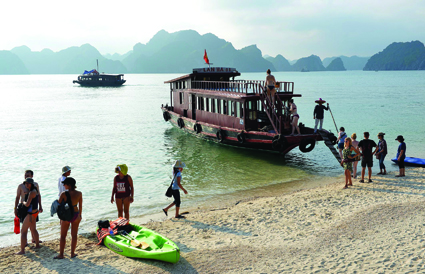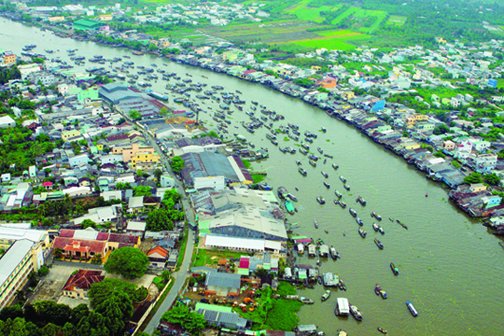>>Thang Long - Hanoi: A long process of development
The capital city of Hanoi, formerly known as Thang Long (land of the soaring dragon), is located in the heart of the Hong (Red) River Delta and northern region of Vietnam. Covering 3,324 square kilometers, the capital consists of 10 urban districts, one town and 18 rural districts with more than 6,450,000 people, ranking second in terms of population and first in acreage in the country. It is also listed among 17 largest capitals in the world. With the contribution of some 10 percent to the country’s GDP, 9 percent to the total export revenues, 13.5 percent to the national industrial production value, 23.5 percent to the total development investment capital and nearly 20 percent to the total state budget revenues (statistics in 2013), Hanoi is the leading economic locomotive of the north and plays an increasing important role in the national economy.
 |
Japan-funded Nhat Tan bridge over the Red River in Hanoi__Photo: Huy Hung/VNA |
Despite difficulties and challenges in the first nine months of the year, the city’s authorities and people exerted their utmost efforts to record positive socio-economic results. Its gross regional domestic product (GRDP) and index of industrial production (IIP) experienced a year-on-year rise of 7.9 percent and 4.5 percent, respectively. Its nine-month export turnover was estimated at more than USD 8.18 billion, up 11.6 percent over the same period last year. Increases were also seen in electronics (54 percent), footwear and leather products (45.5 percent), coal (41.5 percent), crystal products (22 percent), handicraft products (18.8 percent), and farm produce (11.5 percent). Its consumer price index in September rose 0.51 percent over that of last month.
Seeking hi-tech investment
Chairman of the municipal People’s Committee Nguyen The Thao said the capital city hopes to develop its economy by 7 to 7.5 percent annually in the 2016 -20 period.
To meet its socio-economic development demand, Hanoi needs to attract a total investment capital of VND 3.9-4.1 million billion (USD 180-190 billion) for the 2011-20 period, including USD 50-55 billion for the 2012-15 period. It wishes to lure up to 20 percent of this total from the foreign direct investment (FDI).
The city has publicized the list of eight projects calling for FDI during 2014-15, four of them are included in the country’s list of 127 projects calling for foreign investment through 2020.
In addition, four other projects in Hanoi are named in the country’s list, including the Mai Dich-Thang Long section of a USD 205-million expressway project on the third belt road of Hanoi, a USD 1.35-billion urban railway project (line 6) from the inner city to Noi Bai international airport, USD 300-million second phase of the Da River Water Plant, USD 210-million Nam Son solid waste treatment zone, and the USD 150-million hi-tech waste treatment plant.
According to director of the municipal Planning and Investment Department Ngo Van Quy, in the coming time, apart from its existing biggest partner, Japan, the city will strive to attract potential investors from the Republic of Korea (RoK), the United States and the European Union with priority to large-sized projects using high technology.
To achieve the targets, the capital city will have to finalize its investment attraction policies, further reform administrative procedures, improve the investment climate and provincial competitiveness index (PCI).
Earlier, in June Hanoi adopted an investment promotion program for 2014-2015 with an orientation toward 2020 in order to promote investment on a selective basis, target strategic partners and key foreign markets as well as hi-tech sectors with high added value.
In parallel with hosting investment promotion programs at home and abroad, Hanoi will also pay due heed to spurring local investment through increasing support for licensed projects and hosting frequent dialogues with investors to promptly tackle their problems.
In early August, the city initiated a program to provide interest rate incentives for medium- and long-term loans of expanding investment projects based in the city to help them overcome difficulties amid the slow economic recovery.
Under the program, throughout the year, the city will offer a 0.2 percent per month loan interest rate for loans of long term or medium term of at least one year for Hanoi-based businesses who get loans for investing in new projects, expanding existing projects and innovating techniques and technologies.
According to the Foreign Investment Agency under the Ministry of Planning and Investment, in the first half of this year, Hanoi attracted USD 583 million in FDI, representing a year-on-year increase of 30 percent and 45 percent of the city’s total 2014 FDI target.
Also in the reviewed period, the city licensed 145 new foreign-invested projects worth USD 116 million and allowed 50 licensed projects to increase their capital by USD 467 million.
The manufacturing and processing industry ranked first among industries in terms of FDI attraction, representing 40 percent of the city’s total while trade made up 20 percent and science and technology, 14 percent.
The RoK ranked first among foreign investors, accounting for around 36 percent of the total investment, followed by Japan at 35.7 percent and Hong Kong and China at 12.3 percent.
As a result, Hanoi currently stands third in FDI attraction ranking. By the end of the first half, the city was home to 2,806 registered FDI projects worth USD 21.2 billion. Growing visibility of global players like Japan’s Panasonic and Canon in its industrial parks (IPs) have made a significant contribution to the local industrial production and export development.
As of June, foreign invested enterprises (FIEs) posted revenues of USD 4.86 billion, up by 12.3 percent over the last year. FIEs also contributed more than USD 2.6 billion, representing 48.6 percent, to the city’s total export turnover.
Hanoi is currently home to 19 industrial parks (IPs) and hi-tech parks, including Hoa Lac hi-tech park under the management of the Ministry of Science and Technology, eight operating IPs and five others under construction.
Tourism development
Hanoi is not only a political, economic, cultural and scientific hub but also the second largest tourism center in the country.
Throughout more than one thousand years of its eventful history, marked by destruction, wars and natural calamities, Hanoi still preserves many ancient architectural works including the Old Quarter and over 600 pagodas and temples. Famous sites include the One-Pillar pagoda (built in 1049), the Temple of Literature (built in 1070), the Thang Long royal citadel, the Hanoi opera house and President Ho Chi Minh memorial complex.
Hanoi also characteristically contains 18 beautiful lakes such as Hoan Kiem lake, West lake, and Truc Bach lake, which are the lungs of the city, with their surrounding gardens and trees providing a vital source of energy.
With a total of 5,000 historical sites, 1,350 traditional craft villages, and a large number of intangible cultural heritages and eco-tourism sites, the capital city has been ranked amongst the world’s top ten emerging tourist destinations and is one of the six must-see cities in Asia by the world’s prestigious tourism newspapers.
Deputy director of Hanoi’s Culture, Sports and Tourism Department Mai Tien Dung said the city’s tourism sector has paid special attention to promote the capital city’s image to the world’s key markets such as France, Russia, Japan, the Republic of Korea, a number of European and ASEAN nations.
The city has regularly participated in conferences of the Council for Promoting Tourism in Asia and meetings of Asian Network of Major Cities in the 21st century. In addition, its tourism sector has organized fact-finding tours in Hanoi and adjacent areas for foreign travel agents and press delegations.
According to a report of the municipal People’s Committee, the city welcomed around 1. 5 million foreign tourists in the first nine months of the year, a year-on-year rise of 17.1 percent. The number of tourists from the RoK rose 48 percent; the UK, 42 percent; the US, 23 percent; Thailand, 20 percent and France, 37 percent.
The capital city is expected to welcome 3 million foreign holiday-makers this year and 3.2 million foreigners by 2020.
This year, Hanoi is planning to develop the Ba Vi-Suoi Hai zone into a national tourist zone, the transport infrastructure network and transport vehicles for tourists.
Under the city’s tourism development plan through 2020 with vision towards 2030, Hanoi’s tourism sector plans to become the country’s spearhead economic sector with a modern and synchronous infrastructure and a diversity of high-quality and environmental-friendly tourism products imbued with national cultural identity.
Apart from tours to cultural and historical relics, traditional craft villages, and the old quarters, the city will develop ecological tours to Ba Vi National Park, Huong pagoda and entertainment sites in Soc Son, Ba Vi and Bao Son paradise and MICE (meetings, incentives, conferences, exhibitions) tours through organizing international political, cultural and sports events and festivals.-


